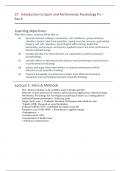CT: Introduction to Sport and Performance Psychology P1 –
San.K
Learning objectives:
After this course, students will be able to
(a) describe theories relating to motivation, self-confidence, group dynamics,
attention, anxiety, talent and expertise, coping, exercise, recovery, goal setting,
imagery, self-talk, relaxation, psychological skills training, leadership,
personality, performance, and injuries, applied to sport and other performance
domains (paraphrasing),
(b) broadly describe how these theories are supported by empirical research
(paraphrasing),
(c) critically reflect on theoretical and empirical work pertaining to mental factors
in performance (evaluating)
(d) predict and argue when interventions to improve performance will be
effective or not (scientific thinking)
(e) integrate knowledge on performance topics from different theoretical
viewpoints and psychological domains (scientific thinking).
Lecture 1: Intro & Methods
- Def: Sport psychology is the scientific study of people and their
behaviors in sport and exercise contexts and the practical application of that knowledge.
- Performance Psychology def: Investigates psychological factors as a starting point to
understand human performance- Achieving goals
- Origin: Early years -> Coubertin: President of Olympics and coined the term.
Triplett (1898): Research on social facilitation
Coleman Griffith (1923)- established first sports psych lab
Formative years (1950-1980) -> From theory to applied settings
Contemporary ->
• Inclusion in the APA
• Incorporation of health issues
• Advances in neuroscience
, -
- Quantitative methods: Surveys (psychometric); Observations; Archival data; Meta-
analyses; Sensor-based assessment / Social sensing; -Experiments ->
• Manipulation of one or more independent
variables
• Quasi-experiments: Independent variable
is not directly manipulated by the
researcher (no randomization, Example:
gender differences)
& Lab versus field studies ->
• Lab: High internal validity- reasonable certainty that IV caused the effects seen on DV,
possible low external validity- same results can’t be obtained for other ppl/samples and in
other situations/places & vv
- Reliability = How consistent is the measure?
o Homogeneity / internal consistency: The extent to which all the items on a scale
measure one construct (e.g., item-to-total correlation, split-half reliability)
o Stability: The consistency of results using an instrument with repeated testing
(e.g., test-rest reliability)
o Equivalence: Consistency among responses of multiple users of an instrument, or
among alternate forms of an instrument (e.g., interrater reliability)
- Validity = How accurate is the measure?
• Content validity: The extent to which a research instrument accurately measures all
aspects of a construct
• Construct validity: The extent to which a research instrument (or tool) measures the
intended construct
• Criterion validity: The extent to which a research instrument predicts an outcome for
another measure.
- Qualitative methods: Interviews; Case studies; Focus groups; Archival
2
, - Evt of descriptive methods: easy to conduct; cost-effective; real world situations;
inaccurate reporting (ie. Social desirability/ bad recollection); observer bias; demand
characteristics; can describe but not predict/explain.
- Experimental methods contain IVs & DVs and random assignment.
Literature for lecture 1:
1. Schüler et al. (2023). Chapter 1: Introduction to Sport and Exercise Psychology -
Theory and Application. (Link to complete textbook).
- Sports psychology is to be distinguished from exercise psychology. Whereas
“sport” is competitive and often achievement goal-oriented, “exercise” is
planned, structured, often repetitive, and purposefully intended to maintain or
improve physical fitness.
- Physical activity is an umbrella term that includes biking to work or taking the
stairs and is defined as all movements produced by skeletal muscles that result
in energy expenditure.
- 4 indicators of the accelerated internationalization of sport psychology are:
Common language of science being English, Impact factor- the citations an
article gets in the 2 years after its published compared to others,
Internationally composed working groups- more knowledge bc of higher
expertise and networking, and English international study programs- promotes
heterogeneity of exposure in teaching and research and facilitates later
establishment in research.
2. Grijalva et al. (2020). Examining the "I" in team: A longitudinal investigation of the
influence of team narcissism composition on team outcomes in the NBA.
- Conclusion: Having more narcissistic team members on average and more
narcissistic members in core roles is not particularly beneficial nor detrimental
to team functioning early in a team’s lifecycle. It is also clear that narcissism’s
influence was strengthened as familiarity increased. As we mentioned above,
however, the nature of the interactions we observed between mean or core
role narcissism and familiarity did not align with our initial theorizing. To
3
, elaborate, we initially proposed that higher levels of narcissism would become
more harmful over time—but, in fact, we found that lower levels of narcissism
became more beneficial over time
- Overall: We demonstrated that teams with higher levels of narcissism tend to
have poorer coordination, which in turn curbs team performance. Further, the
costs of having one or multiple narcissists on a team increase as team
members become more familiar with one another. Teams with higher
narcissism levels are unable to capitalize on the benefits usually associated
with getting to know one’s teammates better
3. Sanderson (2017). Chapter 1: Introduction and Research Methods
- Similar to lecture
Lecture 2: Attributions, Motivation, Goals-
- Four tools for regulating psychological factors: Self-talk, Imagery, Goal setting &
Relaxation.
- Mechanisms for why goal setting works: 1) Goals help focus attention; 2) Goals
affect creativity; 3) Goals affect persistence; 4) Goals regulate effort.
- Self-confidence is related to performance as studies show moderate effect sizes.
- The mechanisms behind self-confidence helping performance are functional coping
and having lower anxiety so more resources in working memory to use for task at
hand.
- Self-efficacy def by Bandura = The belief that individuals have in their capacity to
perform a particular task at a certain level
- ABC schedule- Example of Self-talk application- Cognitive therapy in a nutshell
-
4




